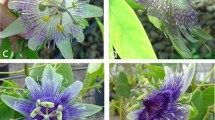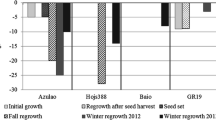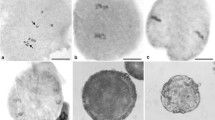Abstract
Randomly Amplified Polymorphic DNA markers (RAPD) were used to assess the hybrid identity of individuals sampled as Phlomis × termessi Davis. Out of 95 primers screened, 11 primers produced reproducible amplification patterns used for discrimination of P. × termessi and their parents. Eleven primers produced 81 bands. Forty two percent of the RAPD bands existed in parents. Of the 54 bands found in P. lycia, 19 were found only in this species and 7 of these were monomorphic. Similarly, of 57 RAPD bands observed in P. bourgaei, 18 were found only in P. bourgaei and 6 of these were monomorphic. Among hybrid individuals, 35 of the 73 markers were monomorphic. Fifteen of these existed in individual parents showing that parents were homozygous for these markers. Of the 35 monomorphic bands observed among hybrid individuals, 5 were present in the samples of one of the parents and completely absent from the samples of the other; therefore, additive inheritance is indicated. Of the 5 additive bands, 1 was inherited from P. bourgaei and 4 were inherited from P. lycia. Among 38 polymorhic markers observed in hybrid individuals, 9 were new and hybrid-specific. Pollen fertility was also investigated. Mean pollen fertility for P. lycia and P. bourgaei was 93% and 97% respectively. However, mean pollen fertility for hybrids was 65% (±10.5).





Similar content being viewed by others
References
Allendorf FW, Leary RF, Spruell P, Wenburg JK (2001) The problems with the hybrids:setting conservation guidelines. Trends Ecol Evol 16(11):613–622
Aparicio A (1997) Fitness components of the hybrid Phlomis × margaritae Aparicio and Silvestre (Lamiaceae). Bot J Linn Soc 124(4):331–343
Arnold ML, Hodges SA (1995) Are natural hybrids fit or unfit relative to their parents? Trends Ecol Evol 10(2):67–71
Azizian D, Moore DM (1982) Morphological and palynological studies in Phlomis L. and Eremostachys Bunge (Labiatae). Bot J Linn Soc 85:249–281
Barraclough TG, Nee S (2001) Phylogenetics and speciation. Trends Ecol Evol 16(7):391–399
Baumel A, Ainouche ML, Misset MT, Gourret JP, Bayer RJ (2003) Genetic evidence for hybridization between the native Spartin maritima and the introduced Spartina alterniflora (Poaceae) in South-west France: Spartina × neyrautii re-examined. Pl Syst Evol 237(1–2):87–97
Bleeker W, Matthies A (2005) Hybrid zones between invasive Rorippa austriaca and native R. sylvestris (Brassicaceae) in Germany: ploidy levels and patterns of fitness in the field. Heredity 94:664–670
Caraway V, Carr GD, Morden CW (2001) Assessment of hybridization and introgression in lava-colonizing Hawaiian Dubautia (Asteraceae: Madiinae) using RAPD markers. Amer J Bot 88(9):1688–1694
Cheng BF, Seguin-Swartz G, Somers DJ (2002) Cytogenetic and molecular characterization of intergeneric hybrids between Brassica napus and Orychophragmus violaceus. Genome 45:110–115
Dadandi MY (2003) A new natural hybrid of Phlomis L. (Lamiaceae) from South Anatolia. The Karaca Arboretum Magazine 7(2):59–66
Dadandi MY, Duman H (2003) A new natural hybrid of Phlomis (Lamiaceae) from Turkey. Ann Bot Fenn 40(4):287–290
Davis PH (1951) Labiatae, Phlomis × termessi. Kew Bull 1951:93
Ellstrand NC, Whitkus R, Rieseberg LH (1996) Distribution of spontaneous plant hybrids. Proc Natl Acad Sci USA 93:5090–5093
Endress PK (2002) Morphology and angiosperm systematics in the molecular era. Bot Rev 68(4):545–570
Faure N, Serieys H, Cazaux E, Kaan F, Berville A (2002) Partial hybridization in wide crosses between cultivated sunflower and the perennial Helianthus species H. mollis and H. orgyalis. Ann Bot 89:31–39
Gobert V, Moja S, Colson M, Taberlet P (2002) Hybridization in the section Mentha (Lamiaceae) inferred from AFLP markers. Am J Bot 89(12):2017–2023
Hedrick PW (1981) The establishment of chromosomal variants. Evolution 35:322–332
Hegarty MJ, Hiscock SM (2005) Hybrid speciation in plants: new insights from molecular studies. New Phytol 165:411–423
Heiser CB (1947) Hybridization between the sunflower species Helianthus annus and H. petiolaris. Evolution 1:249–262
Huber-Morath A (1982) Phlomis L. In: Davis PH (ed) Flora of Turkey and East Aegean Island, vol 7. Edinburgh Univ. Press, Edinburgh, pp 102–126
Isoda K, Shiraishi S, Watanabe S, Kitamura K (2000) Molecular evidence of natural hybridization between Abies veitchii and A. homolepis (Pinaceae) revealed by chloroplast, mitochondrial and nuclear DNA markers. Mol Ecol 9:1965–1974
Johnston JA, Donovan LA, Arnold ML (2004) Novel phenotypes among early generation hybrids of two Louisiana iris species: flooding experiments. J Ecol 92:967–976
Lowe AJ, Abbott RJ (2000) Routes of origin of two recently evolved hybrid taxa: Senecio vulgaris var. hibernicus and York radiate groundsel (Asteraceae). Am J Bot 87(8):1159–1167
Nei M (1972) Genetic distance between populations. Am Nat 106:283–293
Orians CM (2000) The effects of hybridization in plants on secondary chemistry: implications for the ecology and evolution of plant-herbivore interactions. Am J Bot 87(12):1749–1756
Randell RA, Howarth DG, Morden CW (2004) Genetic analysis of natural hybrids between endemic and alien Rubus (Rosaceae) species in Hawaii. Conserv Genet 5(2):217–230
Rieseberg LH (1999) Hybrid classification: insight from genetic map-based studies of experimental hybrids-hybridization and resistance to parasites. Ecology 80(2):361–370
Rieseberg LH, Wendel JF (1993) Introgression and its consequences in plants. In: Harrison R (ed) Hybrid zones and the evolutionary process. Oxford University Press, Oxford, pp 70–109
Rieseberg LH, Carney SE (1998) Plant Hybridization. New Phytol 140:599–624
Rieseberg LH, Raymond O, Rosenthal DM, Lai Z, Livingstone K, Nakazato T, Durphy JL, Schwarzbach AE, Donovan LA, Lexer C (2003) Major ecological transitions in wild sunflowers facilitated by hybridization. Science 301:1211–1216
Seehausen O (2004) Hybridization and adaptive radiation. Trends Ecol Evol 19(4):198–207
Siffelova G, Pavelkova M, Klabouchova A, Wiesner I, Nasinec V, Nasinec I (1998) RAPD fingerprinting of diploid Lolium perenne × hexaploid Festuca arundinacea hybrid genomes. Biol Plant 40(2):183–192
Triest L (2001) Hybridization in staminate and pistillate Salix alba and S. fragilis (Salicaceae): morphology versus RAPDs. Pl. Syst Evol 226(3–4):143–154
Ungerer MC, Baird SJE, Pan J, Rieseberg LH (1998) Rapid hybrid speciation in wild sunflowers. Proc Natl Acad Sci USA 95:11757–11762
Wolfe AD, Xiang QY, Kephart SR (1998) Assessing hybridization in natural populations of Penstemon (Scrophulariaceae) using hypervariable intersimple sequence repeat (ISSR) bands. Mol Ecol 7:1107–1125
Yeh FC, Yang RC (2000) PopGen32 computer program (ver. 1.31) microsoft windows based freeware for population genetic analysis. Http://www.ualberta.ca/∼fyeh/index.htm
Yokoyama J, Fukuda T, Yokoyama A, Maki M (2002) The intersectional hybrid between Weigela hortensis and W. maximowiczii (Caprifoliaceae). Bot J Linn Soc 138:369–380
Yuzbasioglu E, Ozcan S, Acik L (2006) Analysis of genetic relationships among Turkish cultivars and breeding lines of Lens culinatis Mestile using RAPD markers. Genetic Res Crop Evol 53:507–514
Acknowledgments
We would like to thank Sema Yuzbasioglu for correction of English; Dr. Hayri Duman for providing the two samples of hybrids (4905 and 5169); Meryem Kucuk for drawing Fig. 1. This study was funded by the Erciyes University Research Grant EUBAP-01-052-17 and FBA-03-23.
Author information
Authors and Affiliations
Corresponding author
Rights and permissions
About this article
Cite this article
Yüzbaşıoğlu, E., Dadandı, M.Y. & Özcan, S. Natural hybridization between Phlomis lycia D. Don × P. bourgaei Boiss., (Lamiaceae) revealed by RAPD markers. Genetica 133, 13–20 (2008). https://doi.org/10.1007/s10709-007-9177-y
Received:
Accepted:
Published:
Issue Date:
DOI: https://doi.org/10.1007/s10709-007-9177-y




